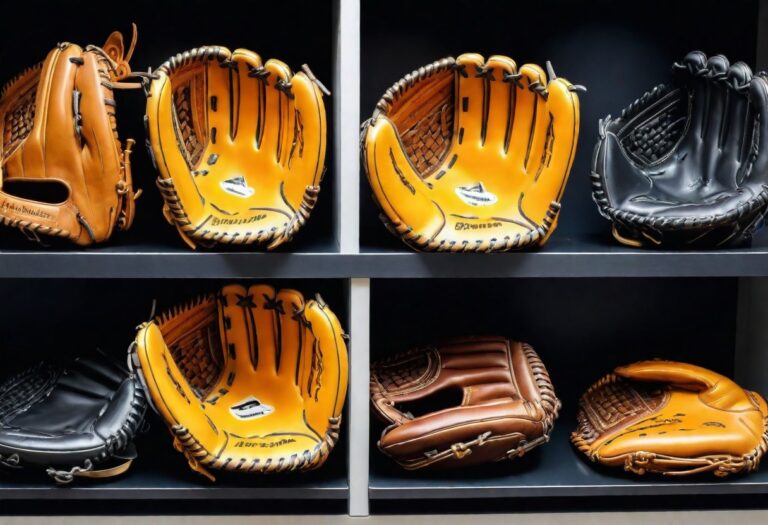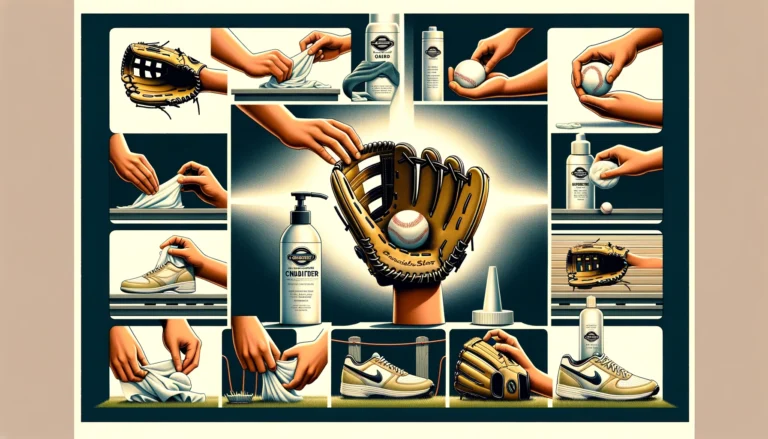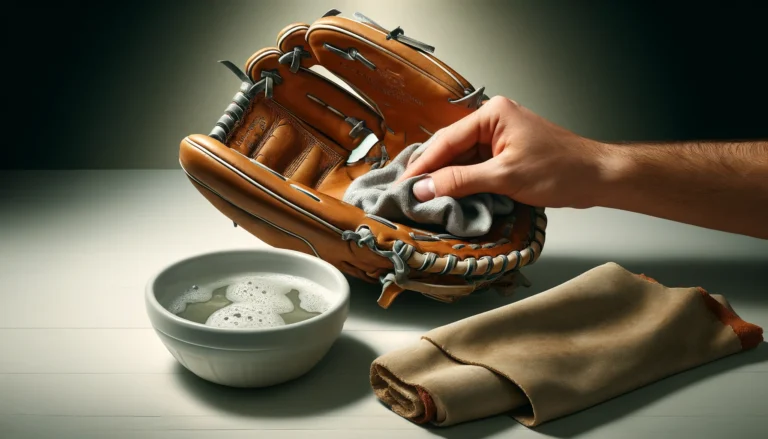What Size Baseball Glove for a 6 Year Old?
As a parent, you want your little slugger to have the best possible start in the game of baseball. Finding the right size baseball glove is crucial for their enjoyment and success on the field.
A glove that’s too big can be cumbersome and difficult to control, while a glove that’s too small can be uncomfortable and even dangerous.
Choosing the perfect fit for your 6-year-old’s hand is essential for developing proper catching technique and fostering a love for the sport.
In this comprehensive guide, we’ll explore the factors to consider when selecting a baseball glove for your 6-year-old.
From measuring their hand size to understanding glove materials and construction, we’ve got you covered.
Key Takeaways
- A T-ball glove sized around 9 to 10 inches is typically suitable for most 6-year-olds, providing a balance between control and comfort.
- Material choice matters; synthetic gloves are easier to break in and more affordable, while leather gloves offer better durability and grip.
- Adjustable features on a T-ball glove, such as straps or laces, can help customize the fit as your child grows and their skills develop.
- Investing in a quality glove that fits your budget can save money in the long run, as a good glove can last several seasons with proper care.
- Safety and maintenance are key; ensuring the glove fits well, is in good condition, and is coupled with other protective gear is essential for young players.
Choosing the Right Size T-Ball Glove

Understanding Glove Sizing for Young Players
When selecting a T-ball glove for a young player, it’s crucial to understand that the right fit is essential for both safety and performance.
Using a glove size chart is the first step in ensuring a perfect fit. A glove that’s too large can slip off during play, while one that’s too small may restrict movement and be uncomfortable.
Glove sizing charts typically categorize gloves by age and position, making it easier to find a suitable option.
For 6-year-olds, who are generally starting in T-ball, the chart simplifies the selection process:
- Age: 6 years old
- Position: T-ball
- Glove Size Range: 9 to 10 inches
By adhering to these guidelines, parents and coaches can avoid common sizing mistakes and help young players focus on developing their skills with confidence and comfort.
Why a 9 to 10-Inch Glove is Ideal for 6-Year-Olds
When a 6-year-old starts playing T-ball, picking the right glove is very an important factor for feeling good and playing well.
A glove measuring 9 to 10 inches in length is often the perfect fit for this age group, striking a balance between manageability and functionality.
This size allows young players to open and close the glove with ease, which is essential for developing their catching and throwing skills.
When selecting a T-ball glove, it’s important to ensure that the glove is not too cumbersome for the child’s hand.
A glove that is too large can hinder their ability to learn proper fielding techniques and may lead to frustration.
Conversely, a glove that is too small can be uncomfortable and restrict movement, potentially impacting the player’s love for the game.
- Size Matters: A glove that is too big or too small can impede a young player’s ability to catch and field effectively.
- Material: Gloves made of synthetic leather or a combination of materials are common for this age, with synthetic options being more affordable and easier to break in.
Ultimately, the right glove size enhances a young player’s experience on the field, contributing to their skill development and enjoyment of the game.
The Importance of a Proper Fit: Comfort and Control
Ensuring that a young player has a glove that fits well is not just about comfort; it’s about safety and performance on the field. A glove that is too loose can easily slip off during a play, potentially leading to injuries or missed catches.
Conversely, a glove that is too tight may restrict movement and hinder a player’s ability to control the ball effectively.
Choosing the right size is crucial for comfort and control. The perfect fit allows for better catching and ball handling, which in turn boosts a young player’s confidence and enjoyment of the game.
It’s essential to use a glove size chart tailored to the player’s age and position to avoid common sizing errors.
When selecting a T-Ball glove for a 6-year-old, consider the following points:
- The glove should have form-fitting finger stalls for a snug fit.
- Look for models with a soft hand slot for added comfort.
- Ensure the glove comes partially broken in for immediate use.
- Take advantage of programs that offer returns or exchanges if the fit isn’t right.
Read Also: How to Measure Your Hand for a Baseball Glove
Material and Design Considerations

Synthetic vs. Leather Gloves: Pros and Cons
When selecting a T-ball glove for a young player, the choice between synthetic and leather materials is crucial.
Synthetic leather gloves are favored for their affordability and ease of break-in, making them a practical option for beginners.
In contrast, leather gloves are renowned for their durability and superior grip, though they come with a higher price tag and require more effort to soften.
The decision often boils down to personal preference and the player’s level of commitment.
Here’s a quick comparison:
| Synthetic Leather Gloves: | Leather Gloves: |
| More affordable | More durable |
| Easier to break in | Better grip |
| Lighter weight | Higher quality feel |
It’s important to weigh these pros and cons against your child’s needs and how long they intend to use the glove.
While synthetic gloves might be more cost-effective initially, investing in a leather glove could be more economical over time if it means avoiding the need for frequent replacements.
Features to Look for in a T-Ball Glove
When selecting a T-ball glove for a 6-year-old, it’s crucial to focus on features that enhance the playing experience while ensuring safety and ease of use.
Look for a glove that is lightweight and designed for the small hands of young players. A glove that’s too heavy or bulky can hinder their ability to learn and enjoy the game.
Key features to consider include:
- Padding: Extra padding in the palm and fingers can provide both protection and comfort, helping to build confidence as young players learn to catch and field the ball.
- Webbing: The webbing connects the thumb and fingers of the glove. Choices like closed web, open web, and H-web cater to personal preferences and the position played.
- Material: Synthetic leather gloves are often more affordable and easier to break in, which can be beneficial for young players who are still developing their skills.
Remember, a glove with the right features can make a significant difference in your child’s T-ball experience, contributing to their development and love for the game.
Ensuring Durability and Ease of Use
When selecting a T-Ball glove for a 6-year-old, durability is a key factor to consider. A durable glove will withstand the rigors of play and last through multiple seasons.
Gloves made with reinforced stitching and high-quality materials are more likely to endure the wear and tear of frequent use.
Ease of use is equally important for young baseball players though. A glove that is easy to open and close allows for better play and more enjoyment on the field.
Look for gloves with features such as soft, pliable materials and adjustable wrist straps, which can help a child handle the glove with ease.
- Reinforced stitching ensures the glove can handle the stress of catching and fielding.
- Quality materials like leather or high-grade synthetics contribute to the glove’s longevity.
- Soft, pliable materials make the glove easier for small hands to manipulate.
- Adjustable wrist straps allow for a snug fit, accommodating growth and different hand sizes.
Read Also: What is the Best Baseball Glove Brand
Breaking In and Adjusting the Glove
Tips for Breaking In a New T-Ball Glove
Breaking in a new T-ball glove is essential for ensuring it conforms to the shape of your child’s hand, providing both comfort and better control of the ball.
Playing catch regularly is one of the most effective ways to break in a glove. This not only helps soften the material but also creates the perfect pocket for the ball.
To facilitate the break-in process, consider using a glove conditioner or oil. These products help to soften the leather or synthetic material, making it more pliable.
It’s important to apply these conditioners properly, following the manufacturer’s instructions to avoid damaging the glove.
Here’s a simple list of steps to break in your child’s T-ball glove:
- Apply a small amount of glove conditioner or oil to the glove.
- Work the conditioner into the glove with a soft cloth, paying special attention to the pocket and finger areas.
- Play catch for several days to naturally shape the glove.
- Store the glove with a ball in the pocket, secured with a strap or glove wrap, to maintain the shape when not in use.
Adjustable Features for a Custom Fit
Ensuring that a T-Ball glove fits your 6-year-old perfectly is crucial for their comfort and performance on the field.
Adjustable features on a glove can make all the difference, allowing for a custom fit as your child grows and their skills develop.
These features typically include:
- Velcro wrist adjustments: to tighten or loosen the fit around the wrist.
- Flexible back: for a more forgiving fit that accommodates different hand sizes.
- Lacing systems: that can be re-tied or tightened to better contour to the hand.
It’s important to note that while adjustable features offer flexibility, they should not compensate for choosing a glove that is significantly too large.
A glove that is too big can hinder your child’s ability to learn and execute proper fielding techniques.
When selecting a glove, look for one that provides a snug fit with just enough room for growth, and utilize the adjustable features to fine-tune the fit over time.
When to Start the Break-In Process
The break-in process for a T-ball glove should begin as soon as you purchase it.
Starting early ensures the glove will be game-ready when your child needs it. Regular use is key to softening the material and shaping the glove to your child’s hand.
Here are some steps to follow:
- Apply a glove conditioner or oil to soften the leather or synthetic material.
- Engage in frequent games of catch to naturally work the glove.
- Store the glove properly when not in use to maintain its shape and condition.
Remember, the goal is to create a glove that feels like a natural extension of your child’s hand, providing both comfort and control on the field.
By following these steps, you can accelerate the break-in period and enhance your child’s playing experience.
Read Also: Where are Wilson Baseball Gloves Made
Budgeting for Your Child’s T-Ball Glove
Understanding the Price Range for Quality Gloves
When shopping for a T-Ball glove for your 6-year-old, it’s essential to understand that prices can vary widely based on factors such as brand, material, and features.
Quality gloves that offer both comfort and durability typically fall within a certain price range.
It’s important to consider that investing in a slightly higher-priced glove may benefit your child’s playing experience and the glove’s longevity.
For example, gloves from popular series like the A2000 or A1000 are known for their craftsmanship but come at a higher cost.
On the other hand, the Youth series may offer a more affordable option while still providing adequate performance for beginning youth Tball and baseball players.
Here’s a quick breakdown of potential costs:
- Entry-level gloves: $20 – $30
- Mid-range gloves: $30 – $60
- Premium gloves: $60 – $100+
Remember, free shipping offers and return policies can also influence the overall value of your purchase. Look for retailers that provide these benefits to maximize your investment.
Investing in a Glove That Grows with Your Child
When investing in a T-ball glove for your 6-year-old, it’s wise to consider options smaller gloves that can adapt to your child’s growth.
Look for gloves with adjustable wrist closures to ensure a snug fit even as your child’s hand size increases.
This feature allows the glove to remain comfortable and effective over multiple seasons, delaying the need for a replacement.
Gloves with form-fitting finger stalls and soft, flexible materials like cowhide leather can also accommodate growing hands.
These materials tend to mold to the player’s hand shape, providing a personalized fit that can enhance both comfort and performance on the field.
Here are some additional features to consider:
- Gel-like comfort in the hand slot for ease of use.
- Extra padding in the palm and fingers for protection.
- Pre-broken in design, allowing immediate use with minimal break-in time.
Remember, involving your child in the selection process can help ensure they are happy with the glove and more likely to use it with confidence.
A glove that grows with your child is not only a practical investment but also a way to foster their love for the game.
Balancing Cost with Quality and Features
When selecting a T-Ball glove for a 6-year-old, it’s crucial to find a balance between cost, quality, and features.
A high-quality glove, like the Rawlings SURE CATCH, can provide younger players with the durability and performance needed for little league play without breaking the bank.
It’s important to consider that while premium leather gloves may come with a higher price tag, they often offer better fit and longevity compared to their synthetic counterparts.
To make an informed decision, consider the following points:
- Evaluate the materials and craftsmanship of the glove.
- Look for gloves with adjustable features to accommodate growing hands.
- Assess the glove’s design for ease of use and comfort.
Remember, investing in a slightly more expensive glove that offers a better fit and superior features can be more cost-effective in the long run.
It’s about finding the right glove that supports your child’s development in the sport while also providing value for money.
Maintenance and Safety Tips
Routine Care for Longevity of the Glove
To ensure that your child’s T-ball glove remains in top condition for multiple seasons, regular maintenance is key.
Cleaning and conditioning the glove are essential steps that should not be overlooked.
After each use, wipe down the glove with a damp cloth to remove dirt and sweat, and periodically apply a leather conditioner to keep the material supple.
Proper storage is equally important. Always store the glove in a cool, dry place, away from direct sunlight or extreme temperatures, which can degrade the materials.
Here’s a simple checklist to follow:
- Wipe down with a damp cloth after use
- Apply leather conditioner periodically
- Store in a cool, dry place
- Avoid exposure to direct sunlight
- Keep away from excessive moisture and heat
By adhering to these care instructions, you can prolong the life of the glove, ensuring it serves well through the seasons.
Safety Considerations for Young T-Ball Players
Ensuring the safety of young T-ball players is paramount. A properly fitting glove is crucial not only for the player’s performance but also for their protection.
Gloves with additional padding can offer extra comfort and safeguard against impact, which is particularly beneficial for those still mastering the art of catching a throw.
When selecting a T-ball glove, it’s important to consider the overall condition of the equipment. A worn or damaged glove can pose a risk to the player, so regular inspection and maintenance are key.
Alongside the glove, other safety gear such as helmets and protective pads should be used to minimize the risk of injury during play.
Lastly, be aware of the playing environment. Inspect the field for hazards, such as sharp edges on fences or the absence of warning tracks, which could pose a threat to players chasing after balls.
By taking these precautions, you can help create a safer experience for all participants.
What to Do When Your Child Outgrows Their Glove
As your child grows, their T-ball glove may no longer fit as well as it once did.
When this happens, it’s important to consider the next steps to ensure they continue to enjoy the game.
You have a couple of options: passing the glove down to a younger sibling or donating it to a local youth sports organization.
Donating not only gives the glove a second life but also supports the community and helps other children who may not have access to proper baseball equipment.
If you’re considering donation, look for programs like Glove Donations for Kids in Need by Steelo Sports, which aim to provide free pro quality baseball gloves to kids in need across America.
This act of giving can make a significant impact on a young player’s life and foster a sense of generosity in your child.
Lastly, when transitioning to a new glove, remember to account for a break-in period. This ensures that the new glove will be comfortable and fully functional for your child’s hand.
Proper care and maintenance of the new glove will extend its lifespan, allowing for more seasons of play.
Conclusion
In summary, finding the perfect T-ball glove for a 6-year-old is about balancing size, material, and design to ensure a comfortable and effective fit.
A glove measuring 9 to 10 inches in circumference is generally ideal, providing the right balance of control and flexibility for young players.
Whether you opt for synthetic leather for ease of break-in or genuine leather for durability, remember that the glove should be lightweight and manageable for your child.
With prices ranging from $20 to $50, you can find a quality glove that fits your budget and meets your child’s needs.
By taking care of the glove with regular cleaning and proper storage, it can last for several seasons, making it a valuable investment in your child’s T-ball experience.
As they grow and their skills develop, the right glove will be a key part of their enjoyment and success on the field.
Frequently Asked Questions
What size glove should I get for my 6-year-old T-ball player?
A glove that is around 9 to 10 inches in length is typically a good size for a 6-year-old T-ball player.
How do I know if a T-ball glove is the right fit for my child?
The glove should fit comfortably on your child’s hand, with the tip of the fingers reaching the end of the glove but not feeling cramped or restricted.
Can my 6-year-old use a regular baseball glove for T-ball?
While a regular baseball glove can work for T-ball, a glove specifically designed for T-ball may be more lightweight and easier for a young child to use.
What type of material is best for a T-ball glove for a 6-year-old?
Synthetic leather gloves are more affordable and easier to break in, while leather gloves tend to be more durable and offer better grip.
How much should I expect to spend on a T-ball glove for a 6-year-old?
T-ball gloves for 6-year-olds can range in price from $20 to $50 or more, depending on the brand, material, and features.
How can I care for and maintain a T-ball glove for my 6-year-old?
Clean and condition the glove regularly, store it in a cool, dry place, and avoid excessive exposure to moisture, heat, or direct sunlight.







